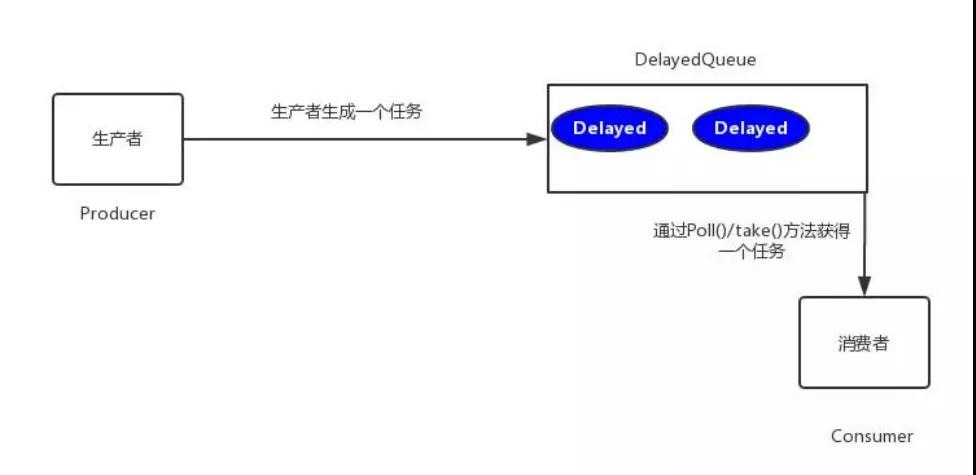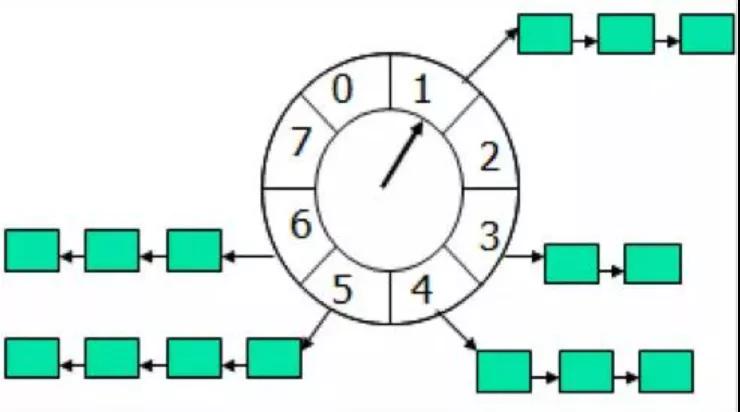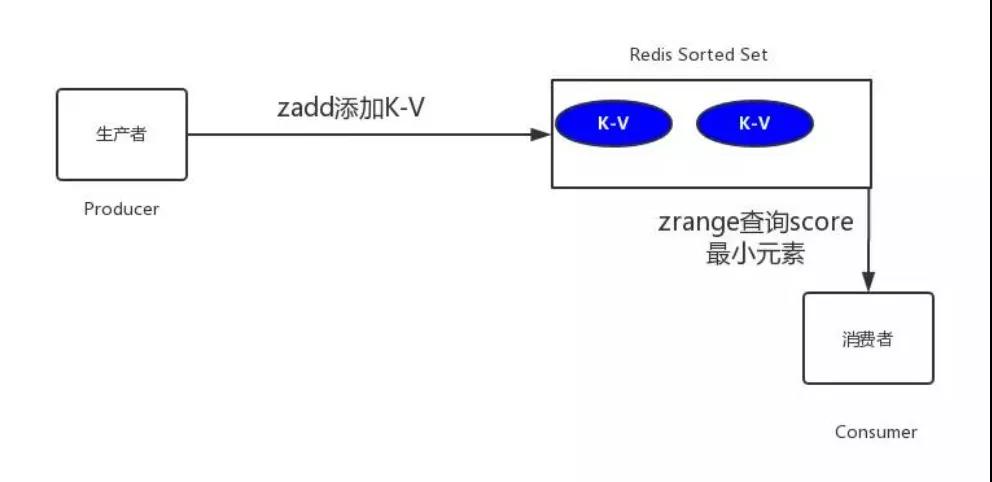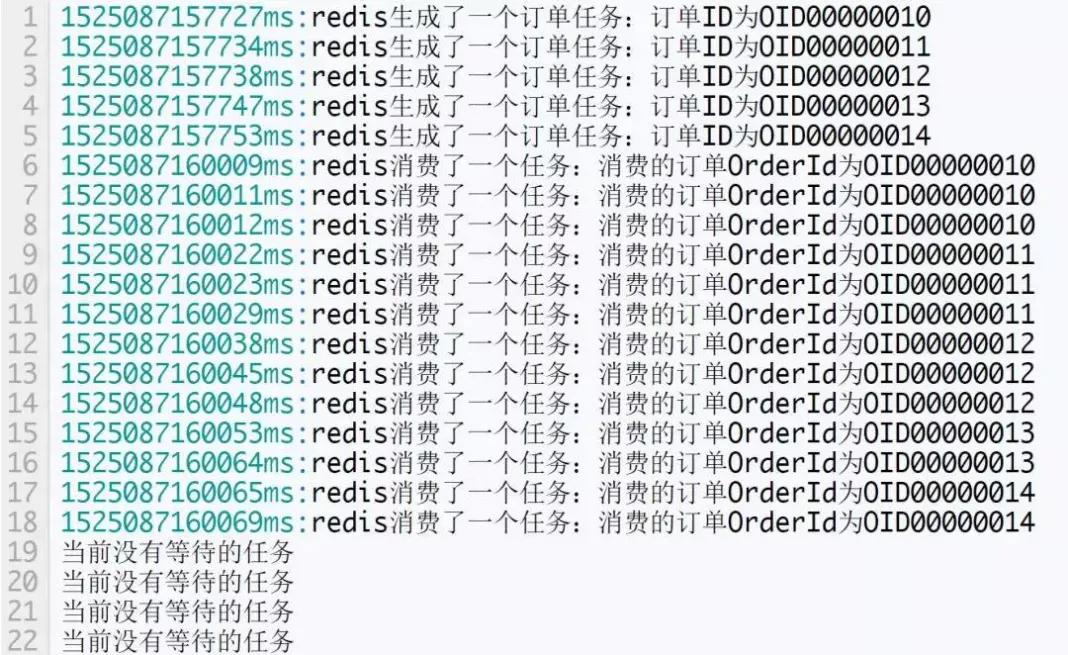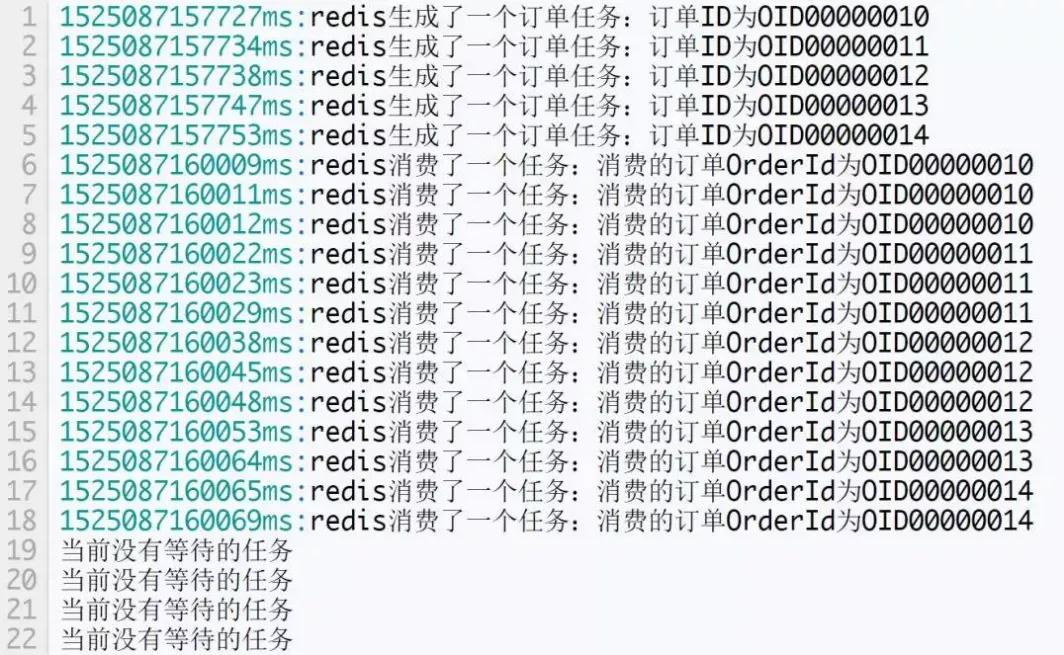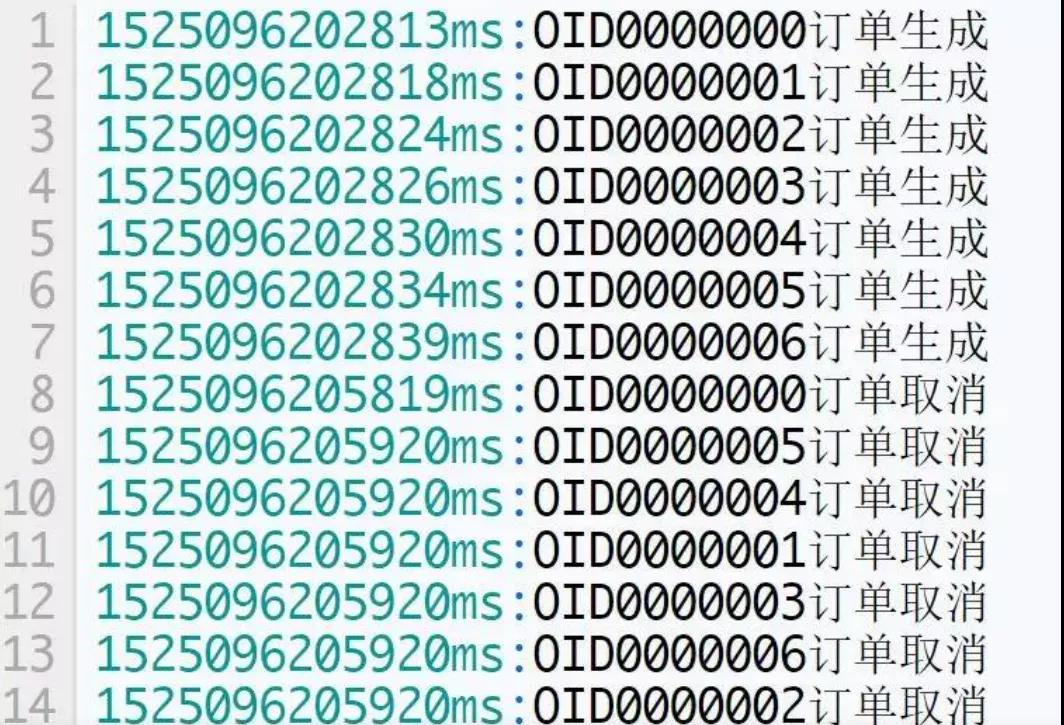图片来自 包图网
对上述的任务,我们给一个专业的名字来形容,那就是延时任务。那么这里就会产生一个问题,这个延时任务和定时任务的区别究竟在哪里呢?
一共有如下几点区别:
- 定时任务有明确的触发时间,延时任务没有
- 定时任务有执行周期,而延时任务在某事件触发后一段时间内执行,没有执行周期
- 定时任务一般执行的是批处理操作是多个任务,而延时任务一般是单个任务
下面,我们以判断订单是否超时为例,进行方案分析。
方案分析
①数据库轮询
思路:该方案通常是在小型项目中使用,即通过一个线程定时的去扫描数据库,通过订单时间来判断是否有超时的订单,然后进行 update 或 delete 等操作。
实现:博主当年早期是用 quartz 来实现的(实习那会的事),简单介绍一下。
maven 项目引入一个依赖,如下所示:
- <dependency>
- <groupId>org.quartz-scheduler</groupId>
- <artifactId>quartz</artifactId>
- <version>2.2.2</version>
- </dependency>
调用 Demo 类 MyJob,如下所示:
- package com.rjzheng.delay1;
- import org.quartz.JobBuilder;
- import org.quartz.JobDetail;
- import org.quartz.Scheduler;
- import org.quartz.SchedulerException;
- import org.quartz.SchedulerFactory;
- import org.quartz.SimpleScheduleBuilder;
- import org.quartz.Trigger;
- import org.quartz.TriggerBuilder;
- import org.quartz.impl.StdSchedulerFactory;
- import org.quartz.Job;
- import org.quartz.JobExecutionContext;
- import org.quartz.JobExecutionException;
- public class MyJob implements Job {
- public void execute(JobExecutionContext context)
- throws JobExecutionException {
- System.out.println("要去数据库扫描啦。。。");
- }
- public static void main(String[] args) throws Exception {
- // 创建任务
- JobDetail jobDetail = JobBuilder.newJob(MyJob.class)
- .withIdentity("job1", "group1").build();
- // 创建触发器 每3秒钟执行一次
- Trigger trigger = TriggerBuilder
- .newTrigger()
- .withIdentity("trigger1", "group3")
- .withSchedule(
- SimpleScheduleBuilder.simpleSchedule()
- .withIntervalInSeconds(3).repeatForever())
- .build();
- Scheduler scheduler = new StdSchedulerFactory().getScheduler();
- // 将任务及其触发器放入调度器
- scheduler.scheduleJob(jobDetail, trigger);
- // 调度器开始调度任务
- scheduler.start();
- }
- }
运行代码,可发现每隔 3 秒,输出如下:要去数据库扫描啦!
优缺点:
- 优点:简单易行,支持集群操作
- 缺点:对服务器内存消耗大;存在延迟,比如你每隔 3 分钟扫描一次,那最坏的延迟时间就是 3 分钟;假设你的订单有几千万条,每隔几分钟这样扫描一次,数据库损耗极大。
②JDK 的延迟队列
思路:该方案是利用 JDK 自带的 DelayQueue 来实现,这是一个无界阻塞队列,该队列只有在延迟期满的时候才能从中获取元素,放入 DelayQueue 中的对象,是必须实现 Delayed 接口的。
DelayedQueue 实现工作流程如下图所示:
其中 Poll():获取并移除队列的超时元素,没有则返回空。take():获取并移除队列的超时元素,如果没有则 wait 当前线程,直到有元素满足超时条件,返回结果。
实现:定义一个类 OrderDelay 实现 Delayed。
代码如下:
- package com.rjzheng.delay2;
- import java.util.concurrent.Delayed;
- import java.util.concurrent.TimeUnit;
- public class OrderDelay implements Delayed {
- private String orderId;
- private long timeout;
- OrderDelay(String orderId, long timeout) {
- this.orderId = orderId;
- this.timeout = timeout + System.nanoTime();
- }
- public int compareTo(Delayed other) {
- if (other == this)
- return 0;
- OrderDelay t = (OrderDelay) other;
- long d = (getDelay(TimeUnit.NANOSECONDS) - t
- .getDelay(TimeUnit.NANOSECONDS));
- return (d == 0) ? 0 : ((d < 0) ? -1 : 1);
- }
- // 返回距离你自定义的超时时间还有多少
- public long getDelay(TimeUnit unit) {
- return unit.convert(timeout - System.nanoTime(),TimeUnit.NANOSECONDS);
- }
- void print() {
- System.out.println(orderId+"编号的订单要删除啦。。。。");
- }
- }
运行的测试 Demo 为,我们设定延迟时间为 3 秒:
- package com.rjzheng.delay2;
- import java.util.ArrayList;
- import java.util.List;
- import java.util.concurrent.DelayQueue;
- import java.util.concurrent.TimeUnit;
- public class DelayQueueDemo {
- public static void main(String[] args) {
- // TODO Auto-generated method stub
- List<String> list = new ArrayList<String>();
- list.add("00000001");
- list.add("00000002");
- list.add("00000003");
- list.add("00000004");
- list.add("00000005");
- DelayQueue<OrderDelay> queue = newDelayQueue<OrderDelay>();
- long start = System.currentTimeMillis();
- for(int i = 0;i<5;i++){
- //延迟三秒取出
- queue.put(new OrderDelay(list.get(i),
- TimeUnit.NANOSECONDS.convert(3,TimeUnit.SECONDS)));
- try {
- queue.take().print();
- System.out.println("After " +
- (System.currentTimeMillis()-start) + " MilliSeconds");
- } catch (InterruptedException e) {
- // TODO Auto-generated catch block
- e.printStackTrace();
- }
- }
- }
- }
输出如下:
- 00000001编号的订单要删除啦。。。。
- After 3003 MilliSeconds
- 00000002编号的订单要删除啦。。。。
- After 6006 MilliSeconds
- 00000003编号的订单要删除啦。。。。
- After 9006 MilliSeconds
- 00000004编号的订单要删除啦。。。。
- After 12008 MilliSeconds
- 00000005编号的订单要删除啦。。。。
- After 15009 MilliSeconds
可以看到都是延迟 3 秒,订单被删除。
优缺点:
- 优点:效率高,任务触发时间延迟低。
- 缺点:服务器重启后,数据全部消失,怕宕机;集群扩展相当麻烦;因为内存条件限制的原因,比如下单未付款的订单数太多,那么很容易就出现 OOM 异常;代码复杂度较高。
③时间轮算法
思路:先上一张时间轮的图。
时间轮算法可以类比于时钟,如上图箭头(指针)按某一个方向按固定频率轮动,每一次跳动称为一个 tick。
这样可以看出定时轮由个 3 个重要的属性参数,ticksPerWheel(一轮的 tick 数),tickDuration(一个 tick 的持续时间)以及 timeUnit(时间单位)。
例如当 ticksPerWheel=60,tickDuration=1,timeUnit=秒,这就和现实中的始终的秒针走动完全类似了。
如果当前指针指在 1 上面,我有一个任务需要 4 秒以后执行,那么这个执行的线程回调或者消息将会被放在 5 上。
那如果需要在 20 秒之后执行怎么办,由于这个环形结构槽数只到 8,如果要 20 秒,指针需要多转 2 圈。位置是在 2 圈之后的 5 上面(20 % 8 + 1)。
实现:我们用 Netty 的 HashedWheelTimer 来实现。
给 Pom 加上下面的依赖:
- <dependency>
- <groupId>io.netty</groupId>
- <artifactId>netty-all</artifactId>
- <version>4.1.24.Final</version>
- </dependency>
测试代码 HashedWheelTimerTest,如下所示:
- package com.rjzheng.delay3;
- import io.netty.util.HashedWheelTimer;
- import io.netty.util.Timeout;
- import io.netty.util.Timer;
- import io.netty.util.TimerTask;
- import java.util.concurrent.TimeUnit;
- public class HashedWheelTimerTest {
- static class MyTimerTask implements TimerTask{
- boolean flag;
- public MyTimerTask(boolean flag){
- this.flag = flag;
- }
- public void run(Timeout timeout) throws Exception {
- // TODO Auto-generated method stub
- System.out.println("要去数据库删除订单了。。。。");
- this.flag =false;
- }
- }
- public static void main(String[] argv) {
- MyTimerTask timerTask = new MyTimerTask(true);
- Timer timer = new HashedWheelTimer();
- timer.newTimeout(timerTask, 5, TimeUnit.SECONDS);
- int i = 1;
- while(timerTask.flag){
- try {
- Thread.sleep(1000);
- } catch (InterruptedException e) {
- // TODO Auto-generated catch block
- e.printStackTrace();
- }
- System.out.println(i+"秒过去了");
- i++;
- }
- }
- }
输出如下:
- 1秒过去了
- 2秒过去了
- 3秒过去了
- 4秒过去了
- 5秒过去了
- 要去数据库删除订单了。。。。
- 6秒过去了
优缺点:
- 优点:效率高,任务触发时间延迟时间比 delayQueue 低,代码复杂度比 delayQueue 低。
- 缺点:服务器重启后,数据全部消失,怕宕机;集群扩展相当麻烦;因为内存条件限制的原因,比如下单未付款的订单数太多,那么很容易就出现 OOM 异常。
④Redis 缓存
思路一:利用 Redis 的 zset。zset 是一个有序集合,每一个元素(member)都关联了一个 score,通过 score 排序来取集合中的值。
zset 常用命令:
- 添加元素:ZADD key score member [[score member] [score member] …]
- 按顺序查询元素:ZRANGE key start stop [WITHSCORES]
- 查询元素 score:ZSCORE key member
- 移除元素:ZREM key member [member …]
测试如下:
- 添加单个元素
- redis> ZADD page_rank 10 google.com
- (integer) 1
- 添加多个元素
- redis> ZADD page_rank 9 baidu.com 8 bing.com
- (integer) 2
- redis> ZRANGE page_rank 0 -1 WITHSCORES
- 1) "bing.com"
- 2) "8"
- 3) "baidu.com"
- 4) "9"
- 5) "google.com"
- 6) "10"
- 查询元素的score值
- redis> ZSCORE page_rank bing.com
- "8"
- 移除单个元素
- redis> ZREM page_rank google.com
- (integer) 1
- redis> ZRANGE page_rank 0 -1 WITHSCORES
- 1) "bing.com"
- 2) "8"
- 3) "baidu.com"
- 4) "9"
那么如何实现呢?我们将订单超时时间戳与订单号分别设置为 score 和 member,系统扫描第一个元素判断是否超时。
具体如下图所示:
实现一:
- package com.rjzheng.delay4;
- import java.util.Calendar;
- import java.util.Set;
- import redis.clients.jedis.Jedis;
- import redis.clients.jedis.JedisPool;
- import redis.clients.jedis.Tuple;
- public class AppTest {
- private static final String ADDR = "127.0.0.1";
- private static final int PORT = 6379;
- private static JedisPool jedisPool = new JedisPool(ADDR, PORT);
- public static Jedis getJedis() {
- return jedisPool.getResource();
- }
- //生产者,生成5个订单放进去
- public void productionDelayMessage(){
- for(int i=0;i<5;i++){
- //延迟3秒
- Calendar cal1 = Calendar.getInstance();
- cal1.add(Calendar.SECOND, 3);
- int second3later = (int) (cal1.getTimeInMillis() / 1000);
- AppTest.getJedis().zadd("OrderId",second3later,"OID0000001"+i);
- System.out.println(System.currentTimeMillis()+"ms:redis生成了一个订单任务:订单ID为"+"OID0000001"+i);
- }
- }
- //消费者,取订单
- public void consumerDelayMessage(){
- Jedis jedis = AppTest.getJedis();
- while(true){
- Set<Tuple> items = jedis.zrangeWithScores("OrderId", 0, 1);
- if(items == null || items.isEmpty()){
- System.out.println("当前没有等待的任务");
- try {
- Thread.sleep(500);
- } catch (InterruptedException e) {
- // TODO Auto-generated catch block
- e.printStackTrace();
- }
- continue;
- }
- int score = (int) ((Tuple)items.toArray()[0]).getScore();
- Calendar cal = Calendar.getInstance();
- int nowSecond = (int) (cal.getTimeInMillis() / 1000);
- if(nowSecond >= score){
- String orderId = ((Tuple)items.toArray()[0]).getElement();
- jedis.zrem("OrderId", orderId);
- System.out.println(System.currentTimeMillis() +"ms:redis消费了一个任务:消费的订单OrderId为"+orderId);
- }
- }
- }
- public static void main(String[] args) {
- AppTest appTest =new AppTest();
- appTest.productionDelayMessage();
- appTest.consumerDelayMessage();
- }
- }
此时对应输出如下:
可以看到,几乎都是 3 秒之后,消费订单。
然而,这一版存在一个致命的硬伤,在高并发条件下,多消费者会取到同一个订单号,我们上测试代码 ThreadTest:
- package com.rjzheng.delay4;
- import java.util.concurrent.CountDownLatch;
- public class ThreadTest {
- private static final int threadNum = 10;
- private static CountDownLatch cdl = newCountDownLatch(threadNum);
- static class DelayMessage implements Runnable{
- public void run() {
- try {
- cdl.await();
- } catch (InterruptedException e) {
- // TODO Auto-generated catch block
- e.printStackTrace();
- }
- AppTest appTest =new AppTest();
- appTest.consumerDelayMessage();
- }
- }
- public static void main(String[] args) {
- AppTest appTest =new AppTest();
- appTest.productionDelayMessage();
- for(int i=0;i<threadNum;i++){
- new Thread(new DelayMessage()).start();
- cdl.countDown();
- }
- }
- }
输出如下所示:
显然,出现了多个线程消费同一个资源的情况。
解决方案:
(1)用分布式锁,但是用分布式锁,性能下降了,该方案不细说。
(2)对 ZREM 的返回值进行判断,只有大于 0 的时候,才消费数据,于是将 consumerDelayMessage() 方法里的:
- if(nowSecond >= score){
- String orderId = ((Tuple)items.toArray()[0]).getElement();
- jedis.zrem("OrderId", orderId);
- System.out.println(System.currentTimeMillis()+"ms:redis消费了一个任务:消费的订单OrderId为"+orderId);
- }
修改为:
- if(nowSecond >= score){
- String orderId = ((Tuple)items.toArray()[0]).getElement();
- Long num = jedis.zrem("OrderId", orderId);
- if( num != null && num>0){
- System.out.println(System.currentTimeMillis()+"ms:redis消费了一个任务:消费的订单OrderId为"+orderId);
- }
- }
在这种修改后,重新运行 ThreadTest 类,发现输出正常了。
思路二:该方案使用 Redis 的 Keyspace Notifications。中文翻译就是键空间机制,就是利用该机制可以在 key 失效之后,提供一个回调,实际上是 Redis 会给客户端发送一个消息。是需要 Redis 版本 2.8 以上。
实现二:在 redis.conf 中,加入一条配置:
- notify-keyspace-events Ex
运行代码如下:
- package com.rjzheng.delay5;
- import redis.clients.jedis.Jedis;
- import redis.clients.jedis.JedisPool;
- import redis.clients.jedis.JedisPubSub;
- public class RedisTest {
- private static final String ADDR = "127.0.0.1";
- private static final int PORT = 6379;
- private static JedisPool jedis = new JedisPool(ADDR, PORT);
- private static RedisSub sub = new RedisSub();
- public static void init() {
- new Thread(new Runnable() {
- public void run() {
- jedis.getResource().subscribe(sub, "__keyevent@0__:expired");
- }
- }).start();
- }
- public static void main(String[] args) throws InterruptedException {
- init();
- for(int i =0;i<10;i++){
- String orderId = "OID000000"+i;
- jedis.getResource().setex(orderId, 3, orderId);
- System.out.println(System.currentTimeMillis()+"ms:"+orderId+"订单生成");
- }
- }
- static class RedisSub extends JedisPubSub {
- <ahref='http://www.jobbole.com/members/wx610506454'>@Override</a>
- public void onMessage(String channel, String message) {
- System.out.println(System.currentTimeMillis()+"ms:"+message+"订单取消");
- }
- }
- }
输出如下:
可以明显看到 3 秒过后,订单取消了。PS:Redis 的 pub/sub 机制存在一个硬伤,官网内容如下:
原文:Because Redis Pub/Sub is fire and forget currently there is no way to use this feature if your application demands reliable notification of events, that is, if your Pub/Sub client disconnects, and reconnects later, all the events delivered during the time the client was disconnected are lost.
翻译:Redis 的发布/订阅目前是即发即弃(fire and forget)模式的,因此无法实现事件的可靠通知。也就是说,如果发布/订阅的客户端断链之后又重连,则在客户端断链期间的所有事件都丢失了。因此,方案二不是太推荐。当然,如果你对可靠性要求不高,可以使用。
优缺点:
- 优点:由于使用 Redis 作为消息通道,消息都存储在 Redis 中。如果发送程序或者任务处理程序挂了,重启之后,还有重新处理数据的可能性;做集群扩展相当方便;时间准确度高。
- 缺点:需要额外进行 Redis 维护。
⑤使用消息队列
我们可以采用 RabbitMQ 的延时队列。RabbitMQ 具有以下两个特性,可以实现延迟队列。
- RabbitMQ 可以针对 Queue 和 Message 设置 x-message-tt,来控制消息的生存时间,如果超时,则消息变为 dead letter。
- lRabbitMQ的 Queue 可以配置 x-dead-letter-exchange 和 x-dead-letter-routing-key(可选)两个参数,用来控制队列内出现了 deadletter,则按照这两个参数重新路由。
结合以上两个特性,就可以模拟出延迟消息的功能。
优缺点:
- 优点:高效,可以利用 RabbitMQ 的分布式特性轻易的进行横向扩展,消息支持持久化增加了可靠性。
- 缺点:本身的易用度要依赖于 RabbitMQ 的运维,因为要引用 RabbitMQ,所以复杂度和成本变高。
作者:hjm4702192
编辑:陶家龙
出处:http://adkx.net/w73gf














